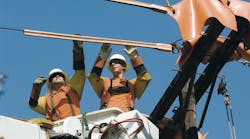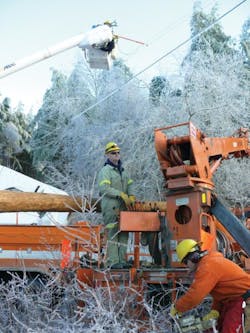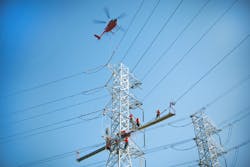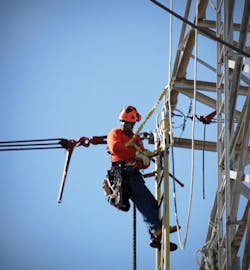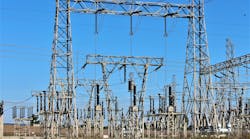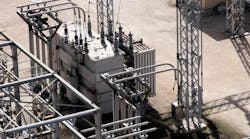The nation’s largest line contractors took a stand against unsafe work practices back in 2004. With the number of linemen injuries and fatalities skyrocketing, the companies forged a strategic partnership with the Occupational Safety and Health Administration (OSHA). Nine years later, they have slashed the rate of injuries and fatalities by more than 50%.
“When you look at the numbers and how we have improved as an industry in terms of serious injuries, burns and workplace fatalities, it is phenomenal,” says Eric Pike, chairman of the partnership, and chairman and CEO of Pike Electric Inc. “Many of the Electrical Transmission & Distribution (ET&D) partners now have as good or better safety records than the utilities because they have taken such a strong stance on safety.”
Ten line contractors currently belong to the ET&D Partnership, including Henkels & McCoy Inc., Pike Electric, Quanta Services Inc., MYR Group Inc., MDU Construction Services Group Inc., Asplundh Tree Expert Co., MasTec Energy Services, Michels Corp., Davis H. Elliott and PLH Group. OSHA, the National Electrical Contractors Association (NECA), the International Brotherhood of Electrical Workers (IBEW) and the Edison Electric Institute (EEI) are also members that work closely with the line contractors to improve safety programs nationwide.
Since some linemen travel from one region to the next to pursue work opportunities, they face a higher risk of sustaining an injury during the first one to three months on the job. To safeguard new employees against harm, the ET&D Partnership focused on standardizing the training and best practices. That way, regardless for which member company a lineman works, he or she will be familiar with the rules and regulations.
This level of collaboration and consistency was one of the key reasons why MDU Construction Services Group signed on as a member of the partnership back in 2004. Like the majority of other line contractors, the company was experiencing too many injuries and looking for ways to protect its field workforce.
“As a union contractor, we were sharing linemen with other contractors, which was a significant factor in joining forces with other companies,” says Frank Richard, chairman of the steering committee for the ET&D Partnership. “We figured we could only change our culture so much with our core group of workers and stood a much better chance of getting through to all the hands of the hall if they were familiar with the partnership training, best practices and commitment to zero injuries.”
This commitment to not only minimizing but eliminating workplace injuries fueled the birth of the partnership back in 2003 and the formalization of it in 2004. Nine years later, the partnership has reduced the number of accidents and fatalities, especially in those areas targeted by the best practices and training programs. For example, the original data gathered by OSHA indicated that the majority of fatalities and injuries stemmed from electrical contact and falls. Today, as a result of the work the partnership has accomplished, these statistics have shown a significant improvement.
“The inspiration behind the partnership and the driver behind it was the ever-present injury and death statistics in this line of work,” says Mike Johnston, executive director of standards and safety for NECA and a member of the steering committee and Task Team 4 (communications). “When it hits home, it kind of forces stakeholders to take responsibility.”
Johnston says the partnership has provided many benefits to NECA’s District 10, which includes a nationwide network of line contractors. Like other members, NECA has been able to establish a more direct and personal relationship with OSHA.
“Obviously, the work of this partnership is important to NECA because it aligns with our standing policy on safety,” he says. “Being in the partnership where we have a direct line of communication with OSHA at the table is of great value to NECA and the others members of this partnership.”
Forming a Partnership
To ensure collaboration and teamwork, each of the member companies must designate representatives to serve as leaders within the partnership. For example, members can serve on an executive team, a steering committee and four task forces for data analysis, training, best practices and communications. Pike says the success of the ET&D Partnership stems from the support from the top management at the line contractors.
“The CEOs in this industry care intensely about our linemen going home safe every day, and this allows them to put their time and effort where it matters most,” Pike says. “The trade associations also support the partnership and help consistently push our best practice methods out to the field.”
At the beginning, it seemed like an insurmountable challenge to bring together some of the nation’s largest electrical contractors who are competitors, says Chuck Kelly, a member of the executive steering team and a director of human resource issues for EEI. So far, however, this has not been an issue, he says.
“The CEOs and chief safety managers within the companies were committed to lowering the accident rates and fatalities in the industry,” Kelly says. “They set their competitive nature aside for the betterment of the industry. When you have these competitive companies that come together for one positive objective, it gives you a better opportunity to succeed.”
Since the use of line contractors has become more prevalent in the power industry, EEI has served as an integral part of the partnership from the beginning, Kelly says. Since 2009, EEI rolled out an internal set of guidelines to its members to help them with contractor oversight selection, and the partnership helps to reinforce that program.
“The individual contractors are working toward target zero as far as eliminating accidents and fatalities, and focusing on proper training methods,” he says. “What we are trying to do in our safety program is make sure we have the relationship with the contractor so we have the opportunity to work with them, see the progress they have made and get the job done in a safe manner.”
Drilling into Data
As more electric utilities are reducing their field workforce because of deregulation and privatization, they are subcontracting their transmission and distribution work to the line contractors. As such, it’s more important than ever before for contractors’ safety programs to align with the utilities’ safety programs, and develop consistent expectations, better training and improved orientation, Johnston says.
As part of this effort, the ET&D Partnership has analyzed years’ worth of data from OSHA reporting forms. By analyzing the forms from member companies, Task Team 1 can determine the areas with the highest number of injuries and fatalities as well as the need for specific training for linemen.
In the past, the task force analyzed OSHA Form 170 Investigation Summary Reports, but these forms didn’t provide information on causal factors for injuries and deaths. For example, if a lineman dies from electrocution, the form currently doesn’t include information on contributing factors such as that the worker wasn’t wearing the proper personal protective equipment.
“When none of the specifics on why the event happened are on the report, it’s difficult for Task Team 1 to develop a reasonable conclusion,” Johnston says. “Our recommendation from the partnership has helped OSHA to be more consistent in its accident investigation reporting and processes.”
Currently, Task Team 1 is moving to OSHA 300 forms, which provide more detailed data. For example, the OSHA 300 forms state when the incident occurred, the type of work the employee was performing at the time, the individual’s job classification, and the type and nature of the injury.
Creating Best Practices
After Task Team 1 identifies those areas with the highest degree of injuries or fatalities, the executive committee works with Task Team 3 to develop best practices for linemen. Once these best practices are established, they must be approved and agreed upon by every partner. So far, the ET&D Partnership has developed and implemented 11 best practices, covering everything from job briefing and fall protection to insulate and isolate methods.
“These are the best practices that matter in the industry, and they help to turn the dial on safety,” Pike says.
Each best practice also includes an implementation plan strategy, which goes out to all of the members. It is up to each of the member companies to implement the best practices within their own companies, Pike says. Having management support for the program has been essential to being able to implement these best practices in the field.
“All of the CEOs of the contracting companies in the partnership actively participate and believe in what we are doing,” he says.
While the management often supports the best practices, it’s been a challenge for the member companies to implement some best practices because of a cultural difference in the field workforce.
“It’s a challenge when you have some people who have been doing things for a long time to tell them that this best practice is the way we’re doing things moving forward,” Johnston says. “Sometimes, there is no issue, and other times, it is met with resistance.”
Bill Mattiford, vice president of corporate safety for Henkels & McCoy and steering committee member since 2005, agreed, saying there has been mixed emotions from the field workforce to the best practices.
“Some people look at it and only see additional rules that they have to follow,” Mattiford says. “Others have seen that we have finally addressed some of the issues that have created fatalities and significant injuries in our industry, and they’re happy to see that some people are addressing these issues and then developing action plans to eliminate those situations.”
For example, the ET&D Partnership eliminated wood pole fall accidents by advising its member contractors to use 100% fall protection. By working with OSHA, the line contractors determined that traditional belts and hooks could not be considered fall protection, which was a game changer for the industry, Johnston says. Today, several manufacturers make belts with an additional retainer to prevent linemen from falling from wood poles and other structures.
“Today, when you look at the data Task Team 1 is producing, the number of falls has dropped,” Johnston says. “It shows that as an industry, since the fall protection best practices implementation, we are making some real progress.”
Training Linemen
Once Task Team 3 develops the best practices, it’s up to Task Team 2 to find ways to deliver the necessary training to the line contractors. To this end, the ET&D Partnership worked closely with OSHA to develop one of the first industry-specific training courses for the transmission and distribution industry.
Mattiford says the development of the 10- and 20-hour OSHA training programs is one of the key benefits for both members and non-members of the ET&D Partnership.
The OSHA 10-hour program covers technical regulations and hazards faced in the transmission and distribution industry. As a result of this training, MDU Construction Services Group has seen a steep decline in injury rates, Richard says.
“This betters our bottom line, but most importantly, it gets our workers home every night,” Richard says.
The OSHA 20-hour program is geared towards leadership and provides supervisory leadership outreach training. The course allows first-level supervisors, foremen, general foremen and superintendents the opportunity to learn how to be a good leader, rather than just a supervisor, Mattiford says.
Both the 10- and 20-hour programs are hands-on, and when a lineman joins a member company, he or she can go through the training program. At Henkels & McCoy, the 10-hour course is spread out over two days, the 20-hour course takes three days to complete. To become an instructor, one must successfully complete the OSHA-500 course, have experience in the industry and attend a four-day ET&D Partnership Train-the-Trainer program.
Upon completion of the program, the instructor can then teach member companies’ linemen. Additionally, local JATC training centers also train apprentices in the ET&D 10-hour program, and in the near future, OSHA trainers will teach the program at the OSHA Training Institutes nationwide.
“Even if a company doesn’t have the size or resources to be part of the partnership, they can still get training,” Pike says.
Looking to the Future
The members of the ET&D Partnership originally signed the contract for two-year terms, but in December 2013, they signed the agreement for another five years. With the re-
signing, came the need for additional goals and objectives for the ET&D Partnership. For example, Task Team 4 is now focusing on telling the story of the partnership, but in the future, its role may evolve to include communicating between the management and the employees in field.
Also, the partnership will perform additional industry surveys, search for causal factors for injuries and deaths, and explore near-miss reporting processes.
“This will be new ground for the partnership,” Johnston says. “We will be exploring the opportunity to look at data for near-misses along with injury data. We want to reduce the fear factor and get folks to report near-misses without fear of retaliation.”
Another goal for the ET&D Partnership is to grow. To become a full member and have a seat on the executive committee, a line contractor must have 500 linemen. Those line contractors with 250 or fewer linemen may join and take advantage of all the training and sharing of best practices, as well. As the ET&D Partnership gains more members, the task forces will work with the executives of the new companies about what issues they are facing and consider other best practices.
“We don’t want to create best practices just to create new guidelines,” Pike says. “We want to make changes that make our industry safer.”
While linemen’s injuries and fatalities may have soared to an alarming rate at the beginning of the ET&D Partnership, the members have come together to implement best practices and invest in more rigorous training for their field workforce. As a result, they have made a difference in the line contracting industry as well as the overall power industry. Pike says he is pleased to continue the ET&D Partnership for another five years, and he is excited about the improvements the line contractors will make in the industry.
“This industry may be viewed as one of the most dangerous because of the risks involved, but we have shown that it doesn’t have to be that way,” he says.
Editor’s note: For more information on the ET&D Partnership, visit powerlinesafety.org.
Members of the ET&D Partnership
Asplundh Tree Expert Co. | www.asplundh.com
Davis H. Elliott Co. | www.davishelliott.com
Edison Electric Institute | www.eei.org
Henkels & McCoy Inc. | www.henkels.com
International Brotherhood of Electrical Workers | www.ibew.org
MasTec Energy Services | www.mastec.com
MDU Construction Services Group Inc. | www.mducsg.com
Michels Corp. | www.michels.us
MYR Group Inc. | www.myrgroup.com
National Electrical Contractors Association | www.necanet.org
Occupational Safety and Health Administration | www.osha.gov
Pike Electric, LLC | www.pike.com
PLH Group Inc. | www.plhgroupinc.com
Quanta Services Inc. | www.quantaservices.com
Sidebar: Leaders of Line Contracting Companies Take Action
The ET&D Partnership consists of several different levels of leadership. Here is how the partnership is structured.
- Executive Committee: The policy-setting body, led by Eric Pike of Pike Electric, is comprised of the CEOs of the member companies.
- Steering Committee: The operational arm, led by Frank Richard of MDU, consists of safety vice presidents, executive directors and safety directors for member companies.
- Working Groups:
- Task Team 1: The Data Analysis Task Force, led by David McPeak of Pike Electric, gathers and conducts an analysis of member companies’ data, identifies cause factors, and identifies training and best practice needs.
- Task Team 2: The Training Task Force, led by James McGowan of Quanta Services, updates and improves all training programs, monitors instructor training, reviews and revises the OSHA 10-hour training program, and updates the leadership training program.
- Task Team 3: The Best Practices Task Force, led by Kevin Watson of Pike Electric, develops best practices, communicates them to the field and monitors the implementation of these best practices.
- Task Team 4: The Communications Task Force, led by Paul DeMara of Henkels & McCoy, communicates the safety messages to the industry, promotes safety outreach, fosters relations with industry partners, coordinates safety stand-downs, and maintains and develops the website.
Sidebar: Best Practices Aim to Improve Linemen’s Safety in the Field
Over the last nine years, the Electrical Transmission & Distribution Partnership has rolled out the following 11 best practices to the field and has two more in development. For more information, visit the website at www.powerlinesafety.org.
- Administrative Controls: Addresses injuries to personnel from improper job planning and risk assessment. Contractors must identify type and quantity of insulate and isolate (I&I) components using preplanning to begin at the pre-bid meeting and preliminary job-site analysis. Line work on conductors or equipment shall be performed when they are de-energized or a portion is de-energized and grounded, when possible.
- Job Briefings: Crews should define routine and critical tasks, identify roles and responsibilities, and indicate what personal protective equipment (PPE) should be used on the job.
- Pre-Use Inspection of Rubber Protective Equipment: All rubber equipment should be inspected prior to each use and examined for damage, wear or contamination.
- Qualified Observer: A crew should identify a member as an observer to ensure clearances are maintained, PPE is used and effective cover-up is installed. This observer must also identify nominal voltages, energized components, minimum approach distances and proper safe work practices while crew members are working on energized lines.
- Insulate and Isolate Safety Performance Check: A safety review process must ensure workers are adhering to the company’s safety rules and proper cover-up procedures.
- Cradle-to-Cradle Use of Insulating Rubber Gloves and Sleeves: When employees are working on energized circuits or equipment using the rubber glove method, rubber protective-insulating gloves and sleeves rated for the exposure of the highest nominal voltage shall be worn “cradle to cradle” when working from an aerial platform.
- Lock-to-Lock Use of Insulating Rubber Gloves and Sleeves: When employees are working on energized circuits or equipment using the rubber glove method, rubber protective-insulating gloves and sleeves rated for the exposure of the highest nominal voltage shall be worn “lock to lock” when employees are working on energized underground equipment.
- Rubber Insulating PPE for the Live-Line Tool Method on Distribution Lines: Workers using the live-line tool work method must use insulating tools designed and intended for use while working on energized equipment and/or conductors. They are not permitted to make direct contact with energized equipment and/or conductors with their hands.
- Safety at Heights: Covers wood poles, metal and concrete poles and lattice structures. Fall protection equipment shall be used when ascending, while in the working position, when changing positions, descending and/or performing rescue operations.
- Isolate and Insulate Techniques for the Rubber Glove Method: Requires effective use of I&I equipment and procedures to provide the necessary level of safety when qualified line workers are using the rubber glove method and working on energized lines and equipment.
- Isolate and Insulate Techniques for the Live-Line Tool Method on Distribution Lines: Requires effective use of I&I equipment and procedures to provide the necessary level of safety when performing live-line tool work on energized lines and equipment.
